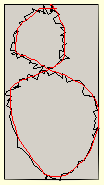What's New - November, 2007
[Home]
November 28, 2007: Age Problem Solver, Version 2 was posted today. It completes the solving process by finding the numerical ages which satisfy the equations generated from the story problems by the first version. It uses last week's Expression Evaluator class to find the solution by "trial and error", a good method for computers which tend to be fast and accurate, but not very smart. The lucky thing is that even programmers like me, who are not so fast, not so accurate, and only medium smart, can tell the computer what to do!
November 21, 2007: Last week's "Age Problem" program produces the equations to solve the problem, but does not actually produce the numeric answers. Thinking to finish it up, I went looking for an expression evaluator which would let me find the set of ages which satisfy the equations, but found that I didn't have any such thing in a very portable form. Today's program, Expression Evaluator, fills that gap. It's contains a new TEval object and a demo program to showing how it works by first converting input expressions to "Postfix" notation list. This is almost a standard for compilers and other programs which must evaluate text versions of arithmetic expressions.
Here's wishing that all those who celebrate Thanksgiving Day, have a safe and happy day with family and friends tomorrow. For the rest of the world, find something to be thankful for anyway - any day is a good day for that!
November 14, 2007: Every high school Algebra
student's dream would be a program to solve "story problems". Dream no
more, here it is!. OK, so it doesn't exactly solve all of the possible
story problems, but it does generate algebraic equations describing at least
the 8 "age" type story problems that have appeared in the current
Mensa
Brain Puzzlers Page-A-Day Puzzle Calendar
. You know, the kind that reads "Al is 3
years older than Bob. In 2 years, Bob will be half as old as Al. How old are
they? " Check out the new
Age Problem Solver program for the answer.
November 8, 2007: The "Know-Don't Know" problem is a puzzle to find two integers based on a conversation between two professors (or programmers), one of whom knows the sum of the 2 numbers and the other who knows only the product. Both know that the numbers are are in the range 2 to 100. Know_Dont_Know Version 2 posted today expands the range of the numbers up to 1000. The change took an hour, but understanding and verifying the results took several days. Being a curious problem solver is a mixed blessing sometimes.
|
|
|
|
|
Original |
Integer rotate 360°in 10° steps |
Real rotate 360° in 10° steps |
November 1, 2007: Here's one for the programmers. A viewer recently sent a sample program showing distortions when rotating a figure defined by an array of points. The problem was that rotated integer coordinates do not stay integers for long. I incorporated a 2nd version using floating point coordinates which solves the problem. More info and download from the Rotate image page in our Delphi Techniques section.
:



